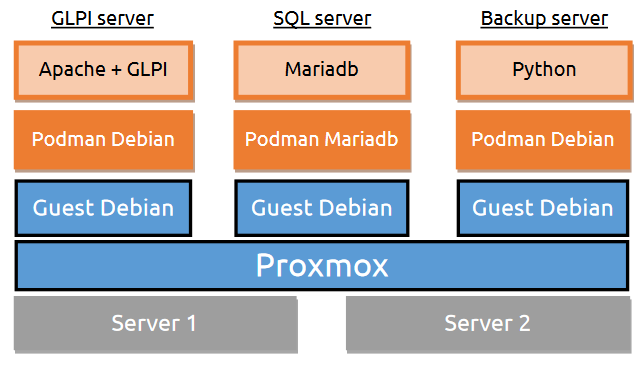GLPI
GLPi was the first project I worked on, with linux and tools around it.
It came after podman, as podman was used to deploy it.
How was it set up
GLPI works in an web server (Apache, Nginx...), some PHP and an SQL database.
Knowing this, we could design a reliable setup, which allows backup, updates, and rollbacks in case of issues.
We decided at first to use a Proxmox server, and host Debian virtual machines, in which we deployed podman images.
This allows the company to have flexibility for future changes, and integrations with other tools (Like Jenkins).
This configuration is still in development, and some optimisations will be done later, after more urgent projects.

In this setup, we created a GLPI image with Apache, PHP, and a GLPI version already downloaded and configured for security.
Why like this
Why Podman
This setup allowed us generate GLPI, images we could deploy as fast as possible, reducing downtime.
If we wanted to rollback an update, we could just deploy the previous image, and use the backup created before the update.
Podman, also allows to have reliability in the images, as we'll always get the same core Debian version, and so it would be less likely for an image to fail.
Using Podman also allowed more flexibility if we wanted to move away from Proxmox to running without VMs, or deploy them somewhere else.
Why separate SQL server
Separating the SQL server allows for more reliability and version control. It allows to choose which version, how to update, and to easilly rollback.
We chose for this one, to get a Mariadb official Image. It was already available, so to accelerate a bit things, we decided to not create it ourselves.
Separate python backup ?
We also deployed a separate python server, which automatically created backups, sending them where we wanted. It would also send us an email with error logs, if it failed to do a backup.